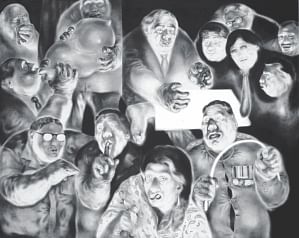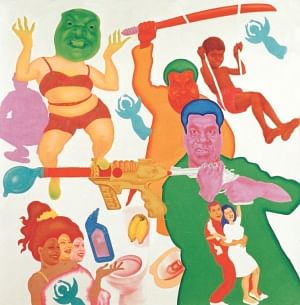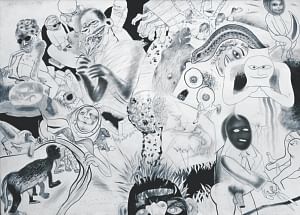| Home - Back Issues - The Team - Contact Us |
 |
| Volume 11 |Issue 09| March 02, 2012 | |
|
|
Art Rhyme and Reason Fayza Haq
A week after Shilpangan had said goodbye to Faiz Ahmad, with paintings, yellow and white flowers, it was 15 days to go for the new venue. With Phalgun in the air, Shishir Bhattacharjee, was on his way to deliver a lecture having been placed as an associate professor with the help of artist, Mohammed Eunus, from the outset. One longed for trees, bushes and hatched terraces—that made Shilpangan a home for the art lovers for over a decade. The carved statue of the bull and farmer, that of the mother and child and the twisted body of the gnome–like figure, were there as before—with tea and “chanachur" for one and all visitors. Dry leaves of spring got crushed, making a wonderful sound, with each footfall. Chitrak is similarly a wee-beloved gallery, now gradually being replaced by Dhaka Art Centre, going by the number of enthusiastic artists. These acclaimed film-makers, well-known reciters like Laila and her husband Hassan Arif , who are painters as well as print-makers. Yet none have the leisurely air the “Shilpangan” with its two Victorian black metal gate lamps still bear. And which beckon art –buffers from early morning. It is to Shilpangan's credit that it has been able to attract artists as talented and versatile as Shishir Bhattacharjee. His wavy hair, his ochre coloured bush-shirt, his glasses and frowning forehead create an image of a man who is always in deep thought. Shishir expresses his concern over the share market, the socio-economic and political environment. He is upset at the value of the Taka and the rising price of fuel that will burden ordinary people even more. He can make beautiful idyllic paintings -- that will please the art gallery owner and the art market. Yet Shishir , like all true painters, wants to be true to himself and paint pictures the will reflect his surroundings as well as his views and dreams. He does not wish to paint pictures of beautiful Bengal. The future of the world itself, with its, frenzy over drying wells, cracked earth, breaking of river sides, the heaping of smoke, noise and sound pollution make Shishir the artist ill at ease. Having studied in India and the best of teachers at the Fine Arts Institute, the artist knows that a futuristic and Munch-like creation will tell the people what is wrong, and make them think of what their civilisation is heading for. With global warming and fear of islands like the Maldives going underwater in the near future, it is natural that an artist like Shishir should be concerned over the man-made and natural devastation around the world. Shishir says, his recent paintings reflect the ugliness of the society around him. In the front pages of the daily newspaper, on the small screen at home, every morning, noon and night, we see murder, mayhem, arson, loot, acid throwing, gang rape. chopped up limbs. etc.
The paintings are in raw colours, they flaunt pistols and guns—the figures appear like actresses in Bangladeshi movies, with garish clothes and villainous moustaches, and attire—as seen in the posters of loud, Bangladeshi commercial films. The colours used are green red and other collection of startling colours. "All around, people are out for power, money, sex and killing, it appears,” says Shishir. In a metropolitan city like Dhaka, one cannot think of anything peacefully. “When one concentrates over something, while alone, at home there is a 'jump cut' with some confusing, overwhelming incident. This is not natural. These are my recent past works. My present work is surrealistic. I'm always guided by the unnatural. One may call it magic unreality. They are more than cartoons and caricatures. These things haunt me. I can always make a soothing, pleasant painting. They make the living room pleasant. But the environment is quite different. I can't mislead myself into thinking that things are ok, and that the environment around me is a happy, contented one.” He says, “Nobody has the time to look at the sky or think of something peaceful and positive anymore. Everybody is in a hurry to get somewhere. Everyone is busy and has no time to give the other person. Are they going in a particular creative direction? The persons are getting alienated. The thoughts appear interrelated. But there is no linking connection; the juxtaposed images only create confusion. I myself would have liked to indulge in peaceful, thought collected lyrical work. But it is not possible or probable. In our Bangla poetry there is a lot of 'Rup golpo' or imagery. One cannot see all these images in paintings. The Neo-colonism after World War II brings in the images of Munch's 'Scream' only. Fauvism, Dadaism and Surrealism reign supreme. Even the days of Pointillism is over.” Shishir is forced into indulging in such images—what else does he have to capture and present? Says Shishir, “If I think of my country and my surroundings, there is distrust, and fake promises and items to delude you only. Recently I cannot do many cartoons for the newspaper. One can understand the pressure from the government. I had a series 'Come and see the game'. I did a lot of work for this series. Then I did the series 'The Picture', in which I used a lot of garish colours, which you mentioned which used popular images from film banners. There was improvisation on the political situation. The paintings were not for the newspaper—they were for myself. In the newspaper one has to edit and censor. Paintings remain personal. I try to use every bit of the freedom I get.” “I've had innumerable exhibits in the country” says Shishir. “I had exhibited in Gautam's “Gallery Kaya: in 2008. The solo was called “Lines and Lyrics”, and was influenced by poems. An artist, as I maintain, is not as pictorial as a poet.”
Asked to speak about his initial entry into the word of art, Shishir says that he could draw from his childhood and his mother encouraged him. He was born in Thakurgaon in the north of Bengal where he did his school and college before joining Dhaka Art College (Institute of Fine Arts, DU), in 1977. The artist Mohammed Eunus encouraged and guided him like an older brother. Teachers, Mahmudul Haque, the late Mahbubul Amin, and Shahid Kabir helped him in getting confidence in himself. He says he learnt a whole lot from Shahid Kabir, apart from what he learnt from Rafiqun Nabi and Farida Zaman. After graduation he studied in Barodha, India. There he got Gholam Mohmmed Sheikh as his guide. He was taught to look and portray political and socio reality and portray it in the best fitted, for one and all. Speaking about the Liberation War of 1971, the spirit of the Movement says Shishir, influenced every artist in Bangladesh. As an artist he, has the responsibility of waking up the society and individuals to fight against injustice and oppression. He admires Qamrul Hasan and SM Sultan, while Zainul Abedin is the “guru' the pioneer, who led the way. Without these three icons, we'd be at sea, says the painter. He had the opportunity to meet them as a school student. Later on, the German Expressionists had their influence in his work. Asked to comment on the Kobi Guru, the artist in Rabindranath Tagore, the artist feels that Rabindranath was the pioneer of Modern Art in the Subcontinent. Without an academic training, as such, with full creative spirit, his spontaneous, visual work has a modern outlook.
|
||||||||||||
Copyright
(R) thedailystar.net 2012 |


